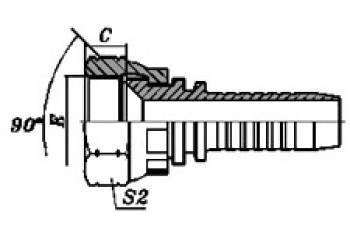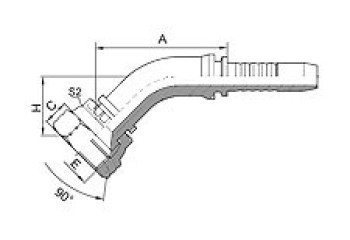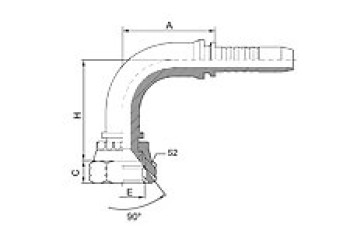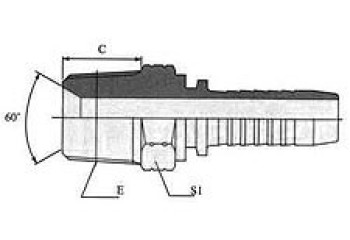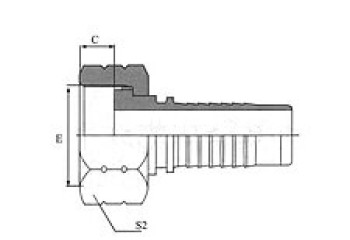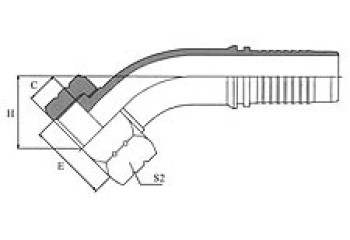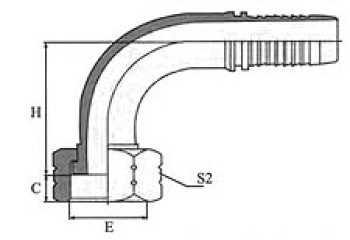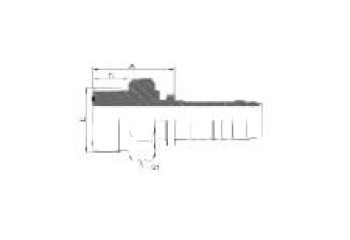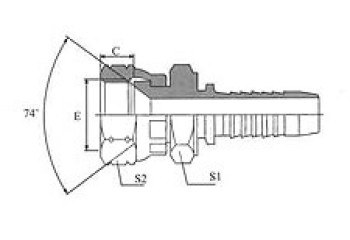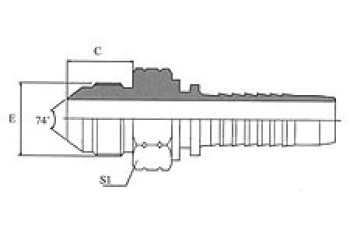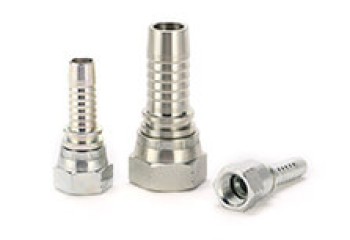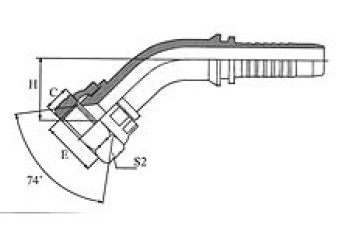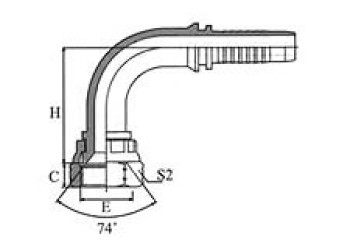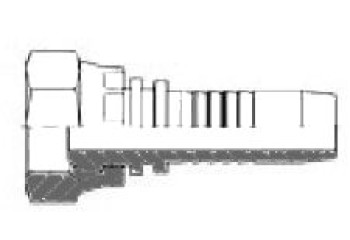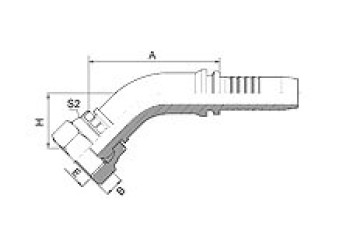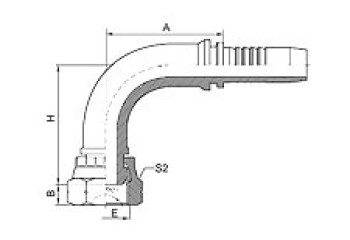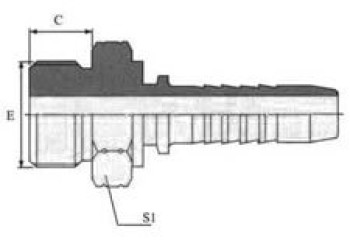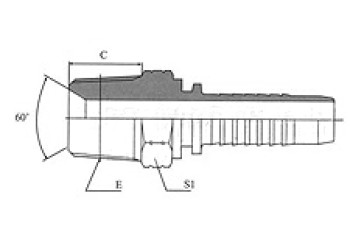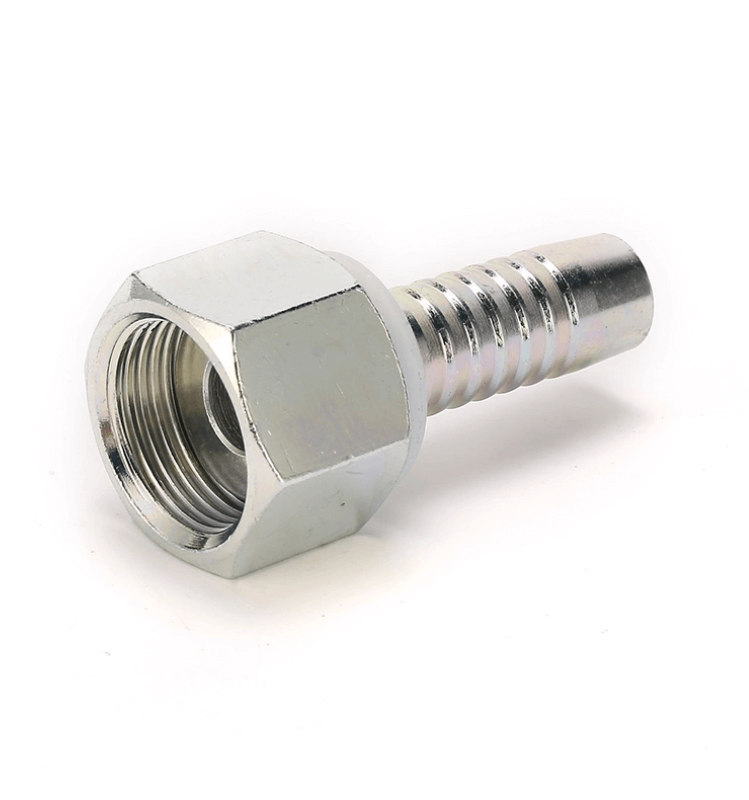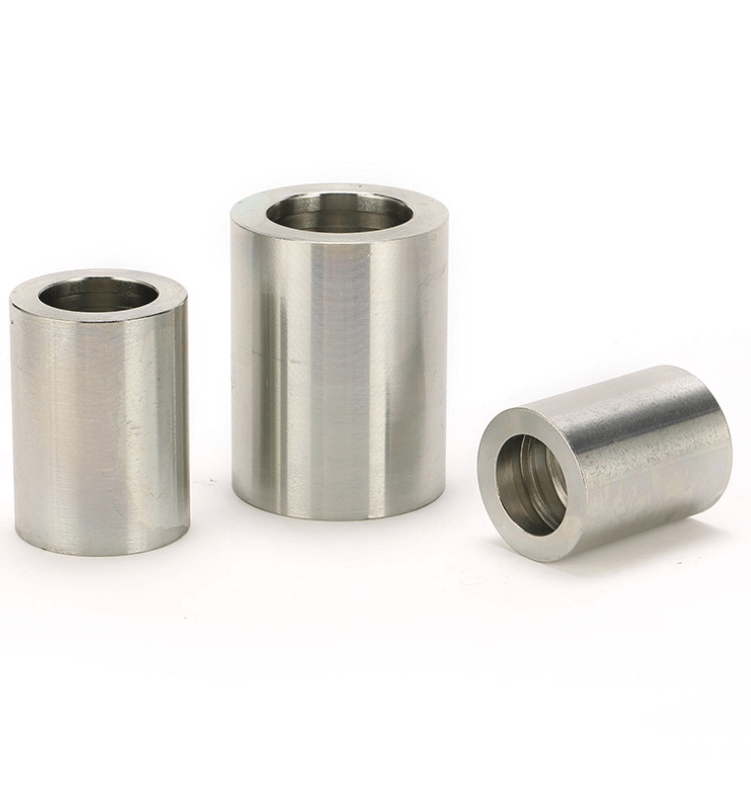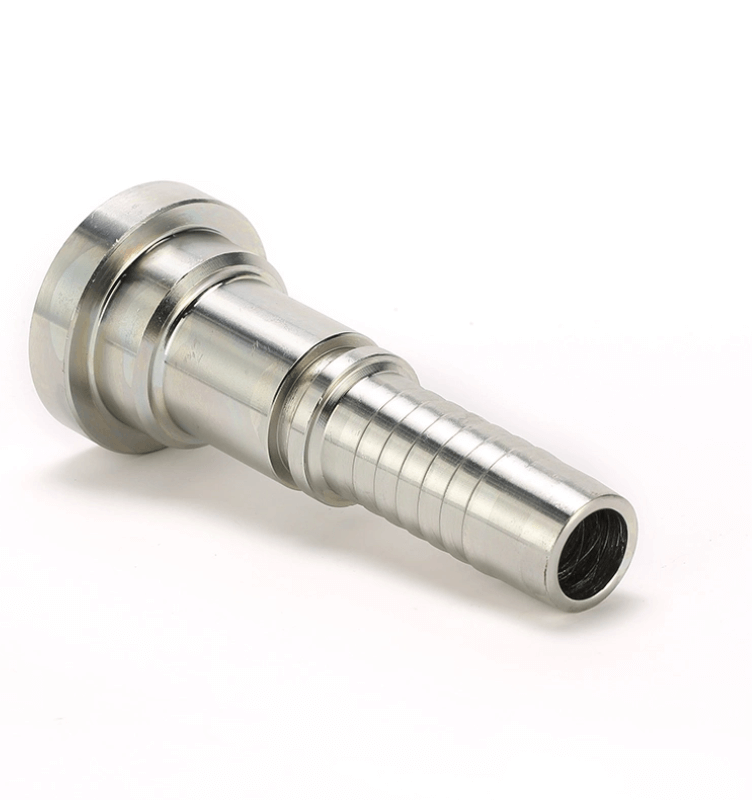
American Standard Fitting
NPT Thread Type Hydraulic Fittings
This thread type is most commonly used in North America. Jinchi Hydraulic recognize it by its tapered outer and inner diameter which is self-sealing. When torqued the flanks of the threads compress against each other forming a leak-tight seal. However, it is still recommended to use PTFE tape or another sealant compound to guarantee a completely leak-tight seal.
A semi-compatible variant of NPT is NPTF fittings(National Pipe Taper Fuel). It ensures an even more leak-free seal. But it is important to note that using these variants together diminishes their leak-free characteristics. NPT threads should be burr-free and lubricated using lubricating paste or tape. Doing so limits corrosion on the threads which otherwise can make future disassembly nearly impossibl
JIC thread Hydraulic Fittings
JIC (or Joint Industry Council) fittings, defined by SAE J514, are compression fittings machined with a 37 degree flare seating surface and parallel threads. They are commonly manufactured in brass, carbon & stainless steel. JIC Fitting hydraulic connections are common in most fluid power systems.
It is a type of flare fitting machined with a 37-degree flare seating surface. JIC fittings are widely used in fuel delivery and fluid power applications, especially where high pressure is involved. JIC hydraulic fittings systems have three components that make a tubing assembly: fitting, flare nut, and sleeve. As with other flared connection systems, the seal is achieved through metal-to-metal contact between the finished surface of the fitting nose and the inside diameter of the flared tubing. The sleeve is used to evenly distribute the compressive forces of the flare nut to the flared end of the tube. Materials commonly used to fabricate JIC fittings include forged carbon steel, forged stainless steel, forged brass, machined brass, Monel and nickel-copper alloys.
ORFS thread Hydraulic Fittings
ORFS fittings are becoming the most popular international fitting type used on global OEM machines due to their high level of sealing and their good vibration resistance. The fittings use the O-ring compression mechanism to seal.The female fittings have flat faces and straight threaded UNF swivel nuts. The male fittings have the O-ring in a groove in the flat face.
Seen as a major advantage, these fittings offer the possibility to build the hose assemblies into fixed distances/spaces, without having to move back other system components due the flat faces of the male and female fittings - the hose assembly can be slotted in.
SAE thread Hydraulic Fittings
SAE straight threads are able to seal because of the 90-durometer Buna-N “O” Ring. This is a highly reliable and reusable thread type. While some thread types require the threads of the male and female end to crush together to form a seal, the O-Ring on this thread type prevents that.
SAE 90° Cone Seal
|
|
|
|
| SAE FEMALE 90° CONE | 45°SAE FEMALE 90° CONE | 90°SAE FEMALE 90° CONE | SAE MALE 90° CONE |
27811/27812 | 27841/27842 | 27891/27892 | 17811/17812 |
ORFS Flat Seal
|
|
|
|
ORFS FEMALE FLAT SEAT | 45º ORFS FEMALE FLAT SEAT | 90º ORFS FEMALE FLAT SEAT | ORFS MALE FLAT SEAT |
| 24211/24212 | 24241/24242 | 24291/24292 | 14211/14212 |
JIC 74° Cone Seal
|
|
|
|
|
| JIC FEMALE 74º CONE SEAT DOUBLE HEXAGON | JIC MALE 74º CONE | JIC FEMALE 74º CONE SEAT | 45º JIC FEMALE 74º CONE SEAT | 90º JIC FEMALE 74º CONE SEAT |
| 26711D/26712D | 16711/16712 | 26711/26712 | 26741/26742 | 26791/26792 |
NPSM 60° Cone Seal
|
|
|
| NPSM FEMALE 60º CONE | 45º NPSM FEMALE 60º CONE | 90º NPSM FEMALE 60º CONE |
| 21611/21612 | 21641/21642 | 21691/21692 |
SAE O-Ring Seal / NPT
|
|
| SAE O-Ring Seal Male | NPT Male |
| 16011/21612 | 15611/15612 |
How to order Hose Fitting
Example:Fitting series is P15611,fitting thread is Z1/2"×14,hose bore is 12mm,and is made of carbon steel the number is P15611-08-08,if made of stainless steel,the number is P15611-08-08SS.
Note:1.For use with braided hoses.2.If use with spiral hoses,the fifth number of hose fitting series change from "1" to "2",for example: from P26711-**-** to P26712-**-**
| MATERIAL | CARBON STEEL | COPPER | STAINLESS STEEL |
| SIGN | BR | SS |
| HOSE DN | 3 | 4 | 5 | 6 | 8 | 10 | 12 | 16 | 20 | 25 | 32 | 40 | 45 | 50 | 64 |
| HOSE DASH | -01 | -02 | -03 | -04 | -05 | -06 | -08 | -10 | -12 | -16 | -20 | -24 | -28 | -32 | -40 |
| HOSE DASH | 02 | 04 | 05 | 06 | 08 | 10 | 12 | 16 | 20 | 24 | 32 |
| BSP THREAD | G1/8"×28 | G1/4"×19 | G3/8"×19 | G1/2"×14 | G5/8"×14 | G3/4"×14 | G1"×11 | G1.1/4"×11 | G1.1/2"×11 | G2"×11 | |
| BSPT THREAD | R1/8"×28 | R1/4"×19 | R3/8"×19 | R1/2"×14 | R3/4"×14 | R1"×11 | R1.1/4"×11 | R1.1/2"×11 | R2"×11 | ||
| NPT THREAD | Z1/8"x27 | Z1/4"×18 | Z3/8"×18 | Z1/2"×14 | Z3/4"×14 | Z1"×11.5 | Z1.1/4"×11.5 | Z1.1/2"×11.5 | Z2"×11.5 | ||
| JIC THREAD | 7/16"×20 | 1/2"×20 | 9/16"×18 | 3/4"×16 | 7/8"×14 | 1.1/16"×12 | 1.5/15"×12 | 1.5/8"×12 | 1.7/8"×12 | 2.1/2"×12 | |
FLANGE SIZE | 1/2" | 3/4" | 1" | 1.1/4" | 1.1/2" | 2" |
Hydraulic hose fittings are necessary when connect various conductors such as tubes, pipes, and hydraulic hoses in the hydraulic system. Most of connections pipe fittings have a male and female component to accommodate the connection and assist with the process of containing and directing the flow of fluid. Also it can prevent any leakages and maintain pressure in the hydraulic system. Consequently, hydraulic fittings need to be strong, versatile, and reliable to operate safely and effectively in their respective applications. So hose fittings typically adhere to strict standards which dictate fitting construction, dimensions, and pressure ratings. Our Jinchi fitting factory are hose supplier and supplier different hydraulic fitting types(custom fitting, flare fittings,JIC fittings, NPT fitting, parker hydraulic fittings, push lock fittings, flared fitting, BSPP fittings, metric hydraulic fittings, bsp fitting, ptfe fitting, stainless steel fittings, SAE fittings, reusable hydraulic hose fitting, swivel pipe fitting).
Types of Fittings
1. Connection Type Fittings
Hydraulic fittings are attached via a number of different connection methods, each with its own conveniences and advantages.
2. Compression Fittings
Compression fittings include all types of fittings which use compressive force to connect the vessel to the fitting.
1)Standard compression fittings use metal gaskets, rings, or ferrules which form a seal on the vessel through compression. The compression is typically made by tightening a nut onto the fitting over the piping and ferrule, compressing, and securing the vessel inside. Standard compression fittings do not require tools to assemble, making them convenient for quick field installations.
2)Bite-type fittings are compressive fittings with a sharpened ferrule that "bites" the vessel when compressed and provides the seal. Bite-type fittings, like standard compressive fittings, require no special tools to assemble, but provide a stronger, higher pressure connection.
3)Flare fittings consist of a body with a flared or coned end. Special flaring tools are used to install the vessel inside the flared end, providing a deep seal. Flare fittings can handle higher pressures and a wider range of operating parameters than standard compression fittings.
3.Crimp Fittings
Crimp fittings involve placing hose over a tubular end and crimping against it with a sleeve, ring, or crimp socket. These fittings typically require crimping tools or machines to make the connections.
4.End Fittings
End fittings provide specific surfaces for connecting vessels in hydraulic systems. Plain ends are fittings with surfaces which allow pipes or tubes to be connected by adhesive, solder, welding, or other permanent means. Welding, when done properly on compatible materials, provides a strong and reliable connection.
5.Flange Fittings
Flange fittings are rims, edges, ribs, or collars with flush surfaces perpendicular to the attached pipe or tube. These surfaces are joined and sealed via clamps, bolts, welding, brazing, and/or threading.
6.Push-to-Connect
Push-to-connect fittings have ends that are designed to accept tubing by pushing it into the end. These fittings typically disconnect via some type of collar retraction. These connections are convenient for sections of the system requiring frequent disconnection and reconnection.
7.Threaded Fittings
Threaded fittings have screw threads (built-in grooves) on their inner (female) or outer (male) surfaces designed to accept connections with matching threads. Threads which provide a simple connection but no seal are called straight threads. Tapered threads are designed to provide a tight seal for gases or fluids under pressure. Seal reliability can be improved by adding a coating or seal tape (Teflon). Especially precise threads are called "dry fit", meaning they seal without the need for an additional sealant, which is important in applications where sealant addition could cause contamination or corrosion. The thread size is measured and based on the inside of the vessel. Thread size standards include NPT (National Pipe Thread) and BSP (British Standard Pipe), though other standards exist and usage often varies by country and industry. Each standard corresponds to a particular number of threads per inch (TPI).
Gallery

